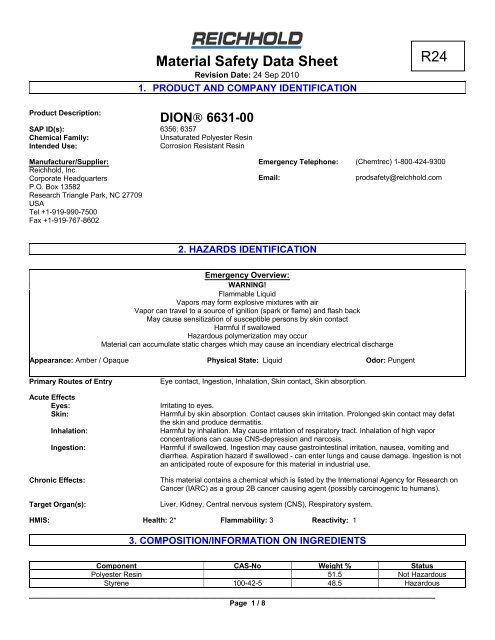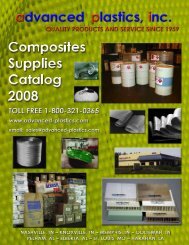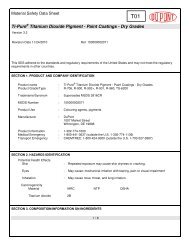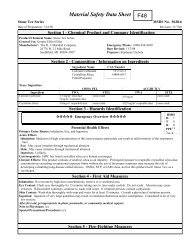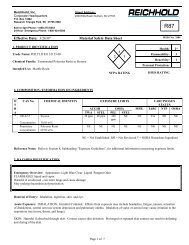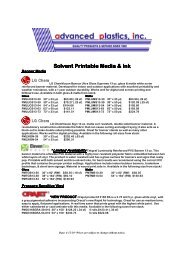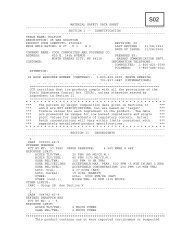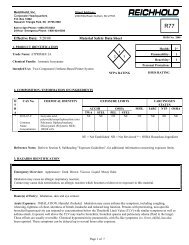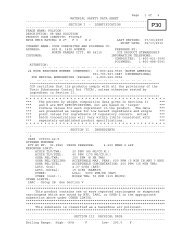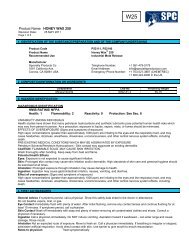Material Safety Data Sheet - Advanced Plastics
Material Safety Data Sheet - Advanced Plastics
Material Safety Data Sheet - Advanced Plastics
You also want an ePaper? Increase the reach of your titles
YUMPU automatically turns print PDFs into web optimized ePapers that Google loves.
<strong>Material</strong> <strong>Safety</strong> <strong>Data</strong> <strong>Sheet</strong><br />
Revision Date: 24 Sep 2010<br />
1. PRODUCT AND COMPANY IDENTIFICATION<br />
Product Description:<br />
DION® 6631-00<br />
SAP ID(s): 6356; 6357<br />
Chemical Family:<br />
Unsaturated Polyester Resin<br />
Intended Use:<br />
Corrosion Resistant Resin<br />
Manufacturer/Supplier:<br />
Reichhold, Inc.<br />
Corporate Headquarters<br />
P.O. Box 13582<br />
Research Triangle Park, NC 27709<br />
USA<br />
Tel +1-919-990-7500<br />
Fax +1-919-767-8602<br />
Emergency Telephone:<br />
Email:<br />
(Chemtrec) 1-800-424-9300<br />
prodsafety@reichhold.com<br />
2. HAZARDS IDENTIFICATION<br />
Emergency Overview:<br />
WARNING!<br />
Flammable Liquid<br />
Vapors may form explosive mixtures with air<br />
Vapor can travel to a source of ignition (spark or flame) and flash back<br />
May cause sensitization of susceptible persons by skin contact<br />
Harmful if swallowed<br />
Hazardous polymerization may occur<br />
<strong>Material</strong> can accumulate static charges which may cause an incendiary electrical discharge<br />
Appearance: Amber / Opaque Physical State: Liquid Odor: Pungent<br />
Primary Routes of Entry<br />
Acute Effects<br />
Eyes:<br />
Skin:<br />
Inhalation:<br />
Ingestion:<br />
Chronic Effects:<br />
Target Organ(s):<br />
Eye contact, Ingestion, Inhalation, Skin contact, Skin absorption.<br />
Irritating to eyes.<br />
Harmful by skin absorption. Contact causes skin irritation. Prolonged skin contact may defat<br />
the skin and produce dermatitis.<br />
Harmful by inhalation. May cause irritation of respiratory tract. Inhalation of high vapor<br />
concentrations can cause CNS-depression and narcosis.<br />
Harmful if swallowed. Ingestion may cause gastrointestinal irritation, nausea, vomiting and<br />
diarrhea. Aspiration hazard if swallowed - can enter lungs and cause damage. Ingestion is not<br />
an anticipated route of exposure for this material in industrial use.<br />
This material contains a chemical which is listed by the International Agency for Research on<br />
Cancer (IARC) as a group 2B cancer causing agent (possibly carcinogenic to humans).<br />
Liver, Kidney, Central nervous system (CNS), Respiratory system.<br />
HMIS:<br />
Health: 2*<br />
Flammability: 3 Reactivity: 1<br />
3. COMPOSITION/INFORMATION ON INGREDIENTS<br />
Component CAS-No Weight % Status<br />
Polyester Resin 51.5 Not Hazardous<br />
Styrene 100-42-5 48.5 Hazardous<br />
__________________________________________________________________________________________<br />
Page 1 / 8
DION® 6631-00<br />
Revision Date: 24 Sep 2010<br />
__________________________________________________________________________________________<br />
3. COMPOSITION/INFORMATION ON INGREDIENTS<br />
Cobalt Compounds
DION® 6631-00<br />
Revision Date: 24 Sep 2010<br />
__________________________________________________________________________________________<br />
Methods for Containment:<br />
Methods for Clean-up:<br />
Prevent spilled material from 1) contaminating soil, 2) entering sanitary sewers, storm sewers,<br />
and drainage systems, and 3) entering bodies of water or ditches that lead to waterways.<br />
Prevent spreading over a wide area (e.g. by containment or oil barriers).<br />
Soak up with inert absorbent material. Remove from surface water (e.g. by skimming or<br />
siphoning). Dispose of contaminated material as waste according to item 13.<br />
7. HANDLING AND STORAGE<br />
Handling:<br />
Storage:<br />
Do not breathe vapours or spray mist. Avoid contact with skin, eyes and clothing. Wash hands<br />
before breaks and immediately after handling the product. Remove and wash contaminated<br />
clothing before re-use. Ensure adequate ventilation. Ground and bond containers when<br />
transferring material. Use spark-proof tools and explosion-proof equipment. Consult your<br />
supplier of promoters and catalysts for additional instructions on proper mixing and usage.<br />
Empty containers may retain product residue (liquid and/or vapor). Do not pressurize, cut,<br />
weld, braze, solder, drill, grind, or expose these containers to heat, flame, sparks, static<br />
electricity, or other sources of ignition as the container may explode and may cause injury or<br />
death. Empty drums should be completely drained and properly bunged. Empty drums should<br />
be promptly returned to a drum reconditioner or properly disposed.<br />
Keep away from heat and sources of ignition. No smoking. Keep away from direct sunlight.<br />
Keep containers tightly closed in a cool, well-ventilated place. Keep at temperature not<br />
exceeding 25°C.<br />
8. EXPOSURE CONTROLS / PERSONAL PROTECTION<br />
Exposure limits<br />
Components with workplace control parameters.<br />
Styrene (CAS #: 100-42-5)<br />
ACGIH TLV - TWA<br />
20 ppm<br />
ACGIH TLV - STEL<br />
40 ppm<br />
OSHA PEL - TWA<br />
100 ppm<br />
OSHA PEL (Ceiling)<br />
200 ppm<br />
Industry PEL<br />
While the federal workplace exposure limit for styrene is 100 ppm, OSHA accepted the styrene industry's<br />
proposal to voluntarily meet a PEL of 50 ppm on an 8 hour TWA and a Short Term Exposure Limit (STEL)<br />
of 100 ppm, 15 minute exposure.<br />
Canada - Alberta OELs<br />
85 mg/m³ (TWA)<br />
170 mg/m³ (STEL)<br />
Ontario OEL (TWA)<br />
35 ppm<br />
Ontario OEL (STEL)<br />
100 ppm<br />
British Columbia OELs<br />
50 ppm (TWA)<br />
75 ppm (STEL)<br />
NIOSH IDLH 700 ppm Immediately dangerous to life or health (IDLH)<br />
Mexico OEL<br />
425 mg/m³ (STEL)<br />
Cobalt Compounds (CAS #: )<br />
ACGIH TLV - TWA<br />
0.02 mg/m³<br />
OSHA PEL - TWA<br />
0.1 mg/m 3 (TWA)<br />
Canada - Alberta OELs<br />
0.02 mg/m³ (TWA)<br />
British Columbia OELs<br />
0.02 mg/m³ (TWA)<br />
Legend<br />
TLV - Threshold Limit Value<br />
TWA - Time weighted average<br />
STEL - Short Term Exposure Limit<br />
IDLH - Immediately Dangerous to Life or Health<br />
ACGIH - American Conference of Industrial Hygienists<br />
OSHA - Occupational <strong>Safety</strong> and Health Administration<br />
NIOSH - National Institute for Occupational <strong>Safety</strong> and Health<br />
OEL - Occupational Exposure Limit<br />
PEL - Permissible Exposure Limit<br />
__________________________________________________________________________________________<br />
Page 3 / 8
DION® 6631-00<br />
Revision Date: 24 Sep 2010<br />
__________________________________________________________________________________________<br />
Engineering Controls:<br />
Personal Protective Equipment<br />
Eye/face Protection:<br />
Skin Protection:<br />
Respiratory Protection:<br />
Use general ventilation to maintain airborne concentrations to levels that are below regulatory<br />
and recommended occupational exposure limits. Local ventilation may be required during<br />
certain operations. Use explosion-proof equipment.<br />
Wear safety glasses with side shields and a faceshield or goggles and a faceshield. Ensure<br />
that eyewash stations and safety showers are close to the workstation location.<br />
Wear chemical-resistant gloves such as polyvinyl alcohol or Viton. Gloves made of nitrile<br />
rubber or polyvinyl chloride (PVC) may be used for splash protection and brief or intermittent<br />
contact with styrenated polyester resin. Please observe the instructions regarding permeability<br />
and breakthrough time which are provided by the supplier of the gloves. Also take into<br />
consideration the specific local conditions under which the product is used, such as the danger<br />
of cuts, abrasion. Impervious clothing. Rubber or plastic boots.<br />
None required if hazards have been assessed and airborne concentrations are maintained<br />
below the exposure limits listed in Section 8. Wear an approved air-purifying respirator with<br />
organic vapor cartridges and particulate filters where airborne concentrations may exceed<br />
exposure limits in Section 8 and/or there is exposure to dust or mists due to sanding, grinding,<br />
cutting, or spraying. Use an approved positive-pressure air-supplied respirator with emergency<br />
escape provisions if there is any potential for an uncontrolled release, airborne concentrations<br />
are not known, or any other circumstances where air-purifying respirators may not provide<br />
adequate protection.<br />
9. PHYSICAL AND CHEMICAL PROPERTIES<br />
Appearance:<br />
Amber / Opaque<br />
Odor:<br />
Pungent<br />
Odor Threshold:<br />
0.2 ppm (Styrene)<br />
Physical State:<br />
Liquid<br />
pH:<br />
Not applicable<br />
Flash Point: 32°C / 89°F<br />
Flash Point Method:<br />
Seta closed cup<br />
Autoignition Temperature:<br />
490°C / 914°F (Styrene)<br />
Boiling Point/Range:<br />
146°C / 295°F (Styrene)<br />
Melting Point/Range:<br />
-30°C / -23°F (Styrene)<br />
Flammability Limits in Air<br />
Lower:<br />
1.1% (Styrene)<br />
Upper:<br />
6.1% (Styrene)<br />
Specific Gravity: 1.04 - 1.08 @ 25°C<br />
Solubility:<br />
Insoluble in H2O<br />
Evaporation Rate: < 1 (BuAc = 1)<br />
Vapor Pressure:<br />
6.12 mmHg @ 20°C (Styrene)<br />
8.16 hPa (Styrene)<br />
Vapor Density: 3.6 (Styrene) (Air = 1.0)<br />
Percent volatile:<br />
47.0 - 50.0 % by weight<br />
VOC Content:<br />
514 g/l (calculated) product as supplied<br />
10. STABILITY AND REACTIVITY<br />
Chemical Stability:<br />
Conditions to Avoid:<br />
Incompatible <strong>Material</strong>s:<br />
Stable under normal conditions. Stable under recommended storage conditions.<br />
Heat, flames and sparks. Contamination by those materials referred to under Incompatible<br />
materials.<br />
Strong acids. Strong oxidizing agents. Metal salts. Polymerization catalysts.<br />
Hazardous Decomposition Products: Hydrocarbons. Carbon monoxide. Carbon dioxide (CO2). Thermal decomposition can lead to<br />
release of irritating gases and vapours.<br />
__________________________________________________________________________________________<br />
Page 4 / 8
DION® 6631-00<br />
Revision Date: 24 Sep 2010<br />
__________________________________________________________________________________________<br />
Hazardous Polymerization:<br />
Polymerization can occur. Hazardous polymerization will occur if contaminated with peroxides,<br />
metal salts and polymerization catalysts. Product will undergo hazardous polymerization at<br />
temperatures above 150 F (65 C).<br />
11. TOXICOLOGICAL INFORMATION<br />
Acute Toxicity<br />
Styrene<br />
LD50 Oral<br />
LC50 Inhalation<br />
5000 mg/kg - rat<br />
2770 ppm - rat (4 hours)<br />
Eye Effects:<br />
Studies indicate that exposures to concentrations of styrene above 200 ppm cause irritation of<br />
the eyes. Styrene causes transient moderate eye irritation without corneal involvement.<br />
Chronic Toxicity<br />
.<br />
Styrene<br />
IARC<br />
Cobalt Compounds<br />
IARC<br />
Legend:<br />
Group 2B - Possibly Carcinogenic to Humans<br />
Group 2B - Possibly Carcinogenic to Humans<br />
IARC - International Agency for Research on Cancer<br />
Repeated dose toxicity:<br />
Mutagenic Effects:<br />
Developmental Toxicity:<br />
Target Organ(s):<br />
In humans, styrene may cause a transient decrease in color discrimination and effects on<br />
hearing. Repeated or prolonged exposure may cause skin irritation and dermatitis, due to<br />
defatting properties of the product. May cause damage to the kidneys, liver, eyes, brain,<br />
respiratory system, central nervous system through prolonged or repeated exposure if inhaled.<br />
Styrene has given mixed positive and negative results in a number of mutagenicity tests.<br />
Styrene was not mutagenic without metabolic activation but gave negative and positive<br />
mutagenic results with metabolic activation.<br />
Results from studies in experimental animals indicate little or no potential for styrene to<br />
produce developmental toxicity.<br />
Liver, Kidney, Central nervous system (CNS), Respiratory system.<br />
12. ECOLOGICAL INFORMATION<br />
Ecotoxicity<br />
Styrene<br />
Bioconcentration factor (BCF) 13.5 - 64<br />
Log Pow 3.16<br />
Freshwater Algae<br />
ErC50 (72h) 4.9 mg/l (Pseudokirchneriella subcapitata)<br />
Toxicity to Aquatic Invertebrates LC50 (48h) 23 mg/l (Daphnia magna)<br />
Freshwater Fish<br />
LC50 (96h) 32 mg/l (pimephales promelas)<br />
13. DISPOSAL CONSIDERATIONS<br />
Waste Disposal Method:<br />
Hazardous waste. Can be incinerated, when in compliance with local regulations.<br />
__________________________________________________________________________________________<br />
Page 5 / 8
DION® 6631-00<br />
Revision Date: 24 Sep 2010<br />
__________________________________________________________________________________________<br />
Contaminated Packaging:<br />
US EPA Waste Number:<br />
Empty containers should be taken for local recycling, recovery or waste disposal.<br />
D001 (IGNITABLE): When discarded in its purchased form, this material would be regulated<br />
under 40 CFR 261.21 as EPA Hazardous Waste Number D001 based on the characteristic of<br />
ignitability.<br />
14. TRANSPORT INFORMATION<br />
DOT<br />
UN-No<br />
UN1866<br />
Proper Shipping Name: RESIN SOLUTION<br />
Hazard Class 3<br />
Packing Group<br />
III<br />
NAERG: 127<br />
TDG<br />
UN-No<br />
UN1866<br />
Proper Shipping Name RESIN SOLUTION<br />
Hazard Class CLASS 3<br />
Packing Group<br />
PGIII<br />
NAERG: 127<br />
IATA<br />
UN-No<br />
UN1866<br />
Proper Shipping Name RESIN SOLUTION<br />
Hazard Class 3<br />
Packing Group<br />
III<br />
Packing Instructions 310<br />
NAERG: 127<br />
IMDG/IMO<br />
UN-No<br />
UN1866<br />
Proper Shipping Name RESIN SOLUTION<br />
Hazard Class CLASS 3<br />
Packing Group<br />
PG III<br />
EmS No.<br />
F-E, S-E<br />
15. REGULATORY INFORMATION<br />
International Inventories<br />
TSCA Inventory Status:<br />
Canadian Inventory Status:<br />
Australian Inventory Status:<br />
Korean Inventory Status:<br />
Philippine Inventory:<br />
All components of this material are listed on the US Toxic Substances Control Act (TSCA)<br />
inventory.<br />
All components of this material are listed on the Canadian Domestic Substances List (DSL).<br />
This product contains only chemicals which are currently listed on the Australian Inventory of<br />
Chemical Substances.<br />
This product contains only chemicals which are currently listed on the Korean Chemical<br />
Substances List.<br />
This product contains one or more chemicals currently not on the Philippine Inventory of<br />
Chemicals and Chemical Substances.<br />
Japan ENCS:<br />
This product contains only chemicals that are currently listed on the Japanese Inventory of<br />
Existing and New Chemical Substances.<br />
__________________________________________________________________________________________<br />
Page 6 / 8
DION® 6631-00<br />
Revision Date: 24 Sep 2010<br />
__________________________________________________________________________________________<br />
Chinese IECS:<br />
This product contains one or more chemicals currently not on the Chinese Inventory of Existing<br />
Chemical Substances.<br />
U.S. Federal Regulations<br />
SARA 313<br />
Section 313 of Title III of the Superfund Amendments and Reauthorization Act of 1986 (SARA). This product contains a chemical or<br />
chemicals which are subject to the reporting requirements of the Act and and Title 40 of the Code of Federal Regulations, Part 372:<br />
Component CAS-No Weight % SARA 313 Status<br />
Styrene 100-42-5 48.5 Listed.<br />
Cobalt Compounds
DION® 6631-00<br />
Revision Date: 24 Sep 2010<br />
__________________________________________________________________________________________<br />
16. OTHER INFORMATION<br />
Prepared By:<br />
Reichhold Product Regulatory Department<br />
Revision Date: 24 Sep 2010<br />
Revision Number: 1<br />
Revision Summary:<br />
General update<br />
Former date: 16 March 2007<br />
This information is provided in good faith and is correct to the best of Reichhold's knowledge as of the date hereof and is designed to<br />
assist our customers; however, Reichhold makes no representation as to its completeness or accuracy. Our products are intended for<br />
sale to industrial and commercial customers. We require customers to inspect and test our products before use and to satisfy<br />
themselves as to suitability for their specific applications. Any use which Reichhold customers or third parties make of this information,<br />
or any reliance on, or decisions made based upon it, are the responsibility of such customer or third party. Reichhold disclaims<br />
responsibility for damages, or liability, of any kind resulting from the use of this information. THERE ARE NO WARRANTIES OR<br />
REPRESENTATIONS, EXPRESS OR IMPLIED, INCLUDING THOSE OF MERCHANTABILITY OR FITNESS FOR A PARTICULAR<br />
PURPOSE WITH RESPECT TO THIS INFORMATION OR TO THE PRODUCT IT DESCRIBES. IN NO EVENT SHALL REICHHOLD<br />
BE LIABLE FOR SPECIAL, INCIDENTAL, OR CONSEQUENTIAL DAMAGES.<br />
End of MSDS<br />
__________________________________________________________________________________________<br />
Page 8 / 8


